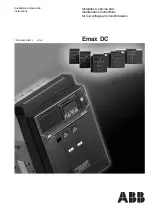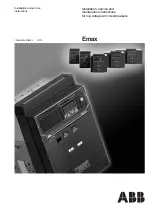
9
2
Operating characteristics and performance
2-1 Overcurrent tripping characteristics
Table 2-4 Current rating correction for hydraulic-magnetic MCCB by mounting angle
Mounting angle
Vertical *
Horizontal
Horizontal
(upside
down)
Slant 15°
(backward)
Slant 45°
(backward)
Slant 15°
(forward)
Slant 45°
(forward)
Rated current
correction f
actor
MCCB
ELCB (Reference)
BW32AAG, BW32SAG
BW50AAG, BW50EAG
BW50SAG, BW50RAG
BW63EAG, BW63SAG
BW63RAG
BW100AAG
BW100EAG
EW32AAG, EW32EAG
EW32SAG
EW50AAG, EW50EAG
EW50SAG, EW50RAG
EW63EAG, EW63SAG
EW63RAG
EW100AAG
EW100EAG
100%
85%
115%
95%
90%
105%
110%
Note: * A 100% rated current correction factor is maintained on a vertical line at any angle as shown in the figure below.
ON
ON
OFF
OFF
ON
OFF
OFF
ON
View from P
ON
P
OFF
ON
OFF
ON
OFF
ON
OFF
ON
ON
OFF
ON
OFF
(4) Mounting angle effects
Special care must be taken regarding the mounting angle
of MCCBs because the angle will affect their operating
characteristics. In a hydraulic-magnetic type, for example, the
operating current varies with the mounting angle because
gravity affects the plunger in the oil dashpot.
(3) Mounting angle
MCCBs are designed to be mounted in parallel with the
vertical plate. Note that different mounting other than
the standard position could alter the MCCB’s operating
characteristic (see Table 2-4). The effect of mounting angle on
the overcurrent trip characteristic varies depending on the type
of trip device as shown in Table 2-3.
Table 2-3 Effect of mounting angle on overcurrent trip
Trip device
Effect of mounting angle
Thermalmagnetic Although the heat radiation is slightly dependent
on mounting angle, the operating characteristic
is hardly affected by it. Therefore, the effect of
mounting angle is negligible.
Hydraulicmag-
netic
The gravity on the iron core in the cylinder varies
depending on the mounting angle. The mounting
angle, then, affects the operating characteristics.
In general, a backward or forward tilt not
exceeding the angle of 10° from the vertical plate
has negligible effect. A larger angle than this
needs the current rating correction as indicated in
the Table 2-4.
(2) Hot-start and cold-start
The cataloged characteristic curve that is called the cold-start
characteristic represents the operating characteristic of an
MCCB that has just been energized at the reference ambient
temperature. The MCCB’s operating characteristic appearing
when overcurrent has just begun to flow after a long period of
steady load current is called the hot-start characteristic.
In general, 50% or 75% of the rated load current is used
as the steady state load current, and the associated
operating characteristics are called the 50% or 75% hot-
start characteristics. With both thermal-magnetic and
hydraulicmagnetic type MCCBs, the hot-start operating time is
shorter than the cold-start operating time as shown in Fig. 2-3.
Fig. 2-3 Hot and cold start characteristics
Cold start
Hot start
Oper
ating time
Current












































